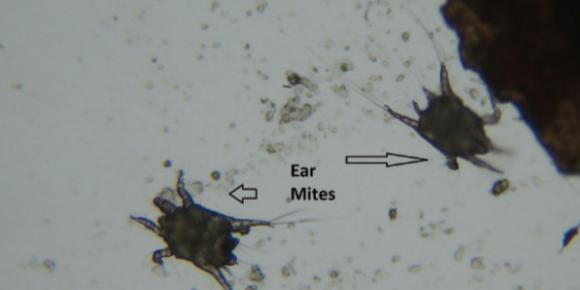Ear Infections in Dogs and Cats: Fighting Otitis

- posted: May 21, 2019
Is your dog shaking her head a lot? Does your cat have a lot of waxy stuff in his ears? Is there a bad odor coming from your pet’s ears? If so, your pet may have otitis which is the fancy doctor word for inflammation or infection of the ear.
What causes ear infections in pets? Excessive bacteria or yeast inside the ear canals, or parasites such as ear mites living in the ear canal (a common problem in cats) can cause an infection. Occasionally, the canal may become red, inflamed and itchy, but not actually infected.
Why do they get yeast or bacteria in the first place? Bacterial and yeast infections occur when conditions inside the ear are right for excessive growth of these organisms. If a pet has food or environmental allergies, the skin lining the ear can become irritated and broken, allowing for these organisms to take hold and cause an infection. Sometimes, a bit of water in the ear canal that does not evaporate such as after a pet has been swimming or had a bath can lead to an infection as bacteria and yeast like a warm, moist place to grow.
Ear mites are more common in young puppies and kittens and more common in cats in general, especially outdoor cats. These parasites live in the ear canal causing thick dry black debris to build up in the canal. They can be spread from one pet to another by close contact with one another. Mild cases have no symptoms, but some pets are quite itchy.
Sometimes, a polyp or tumor in the ear canal can lead to infection as ear wax and debris can remain trapped in the canal.
An ear infection can cause your pet’s ears to get quite itchy and sore. He may shake his head, paw at his ears or rub them on the floor and his ears may look red, may have yellow or brown waxy debris visible in the ear canal and may have a bad odor. Severe or chronic infections may cause the ear canal to swell shut and may cause hardening of the canal and even hearing loss. Dogs with long ear flaps or lots of hair in or around the ear canals such as poodles and Cocker Spaniels have an increased risk of ear problems.
How is an ear infection diagnosed? Your veterinarian will most likely examine your pet, looking inside the ears. Mites are usually visible with the special magnifying otoscope. A sample of the debris in the pet’s ear may be smeared on a slide, stained and examined under a microscope to look for yeast or bacteria. Once in a while, a sample may be sent to a lab for culture to identify the specific type of bacteria present to aid in treating a more resistant infection.
How is an infection treated? Once the type of infection is known, appropriate topical antibiotics, anti-fungal drugs or mite treatments can be administered. In almost all cases, something needs to be applied to the ear canal. Drugs taken orally often do not penetrate the ear canal well, though severe infections may require topical and oral medications. A rinse or flush to clean and medicate the ear, use of ear drops or creams or even a thick medicated paste applied to the ear canal may be used.
Can you prevent ear infections? Maybe. If your pet has chronic infections, determining if she has an underlying allergy to foods or to things in her environment like trees, pollens and grasses and taking measures to control these allergies may limit or eliminate ear infections. Keeping hair trimmed around the ear canals, periodic cleaning of the ear canals and drying pet’s ears after bathing or swimming can also reduce infections.
Ear infections are not usually too serious, but they can make pets very uncomfortable, so, if your pet has symptoms of an ear infection, consult your vet for proper treatment of otitis.
This blog brought to you by the Patton Veterinary Hospital serving York, Red Lion and the surrounding communities.
Location
Patton Veterinary Hospital
425 E Broadway
Red Lion, PA 17356
